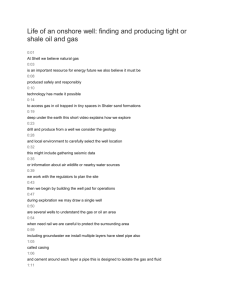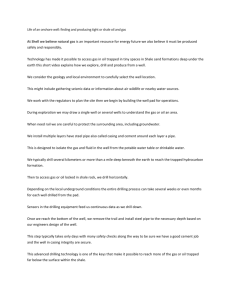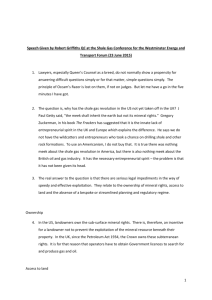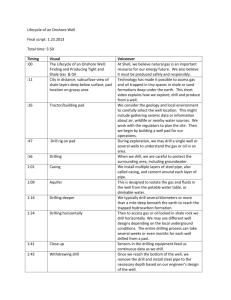Drilling & hydraulic fracturing
advertisement
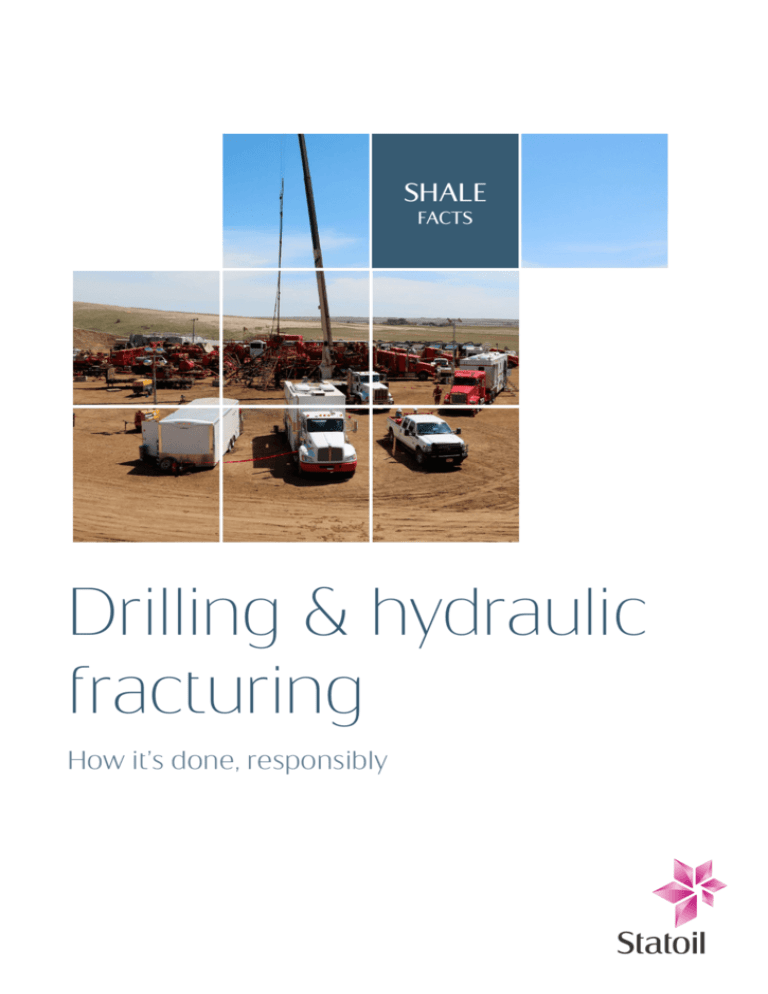
SHALE FACTS Drilling & hydraulic fracturing How it’s done, responsibly Proven Technologies Horizontal drilling and hydraulic fracturing are established technologies used to develop shale resources. Hydraulic fracturing is a proven engineering activity. Since its introduction in 1949, it is estimated that more than 2.5 million wells have been hydraulically fractured worldwide. (Journal of Petroleum Technology) Statoil is committed to developing our shale resources in a safe, responsible and open manner. Protecting groundwater We conduct baseline assessments to evaluate the quality of the groundwater to ensure that our activities are not negatively affecting the freshwater sources in the area. Drilling and hydraulic fracturing 14-40 days A well is drilled vertically until just above the target zone, where it curves before it is directed horizontally into the selected shale formation. After the well is drilled, it is hydraulically fractured to allow oil and gas to migrate into the wellbore and to the surface. Shale well overview Vertical drilling Casing Horizontal drilling Hydraulic fracturing WELL DESIGN Statoil designs its wells with due consideration for local operating environments and challenges. For example, in North America this means cementing at least two casing strings in-place to isolate groundwater aquifers from hydrocarbon bearing zones and performing operational evaluations and diagnostic tests on all well casing after the cementing stage to verify wellbore integrity. Solid waste from drilling Returned (produced) water and drill cuttings (rock from the borehole) are waste products generated by shale oil and gas production. Waste management options include burial onsite or at a landfill, underground injection, re-use treatment or road fill. SECURING THE WELL All wells sites are equipped with a Blow Out Preventer (BOP) at the surface during the drilling phase. Ensuring a safe and stable well Well construction starts with detailed planning of the surface location, borehole, and trajectory to the target location. Geologists advise where to drill based on geological and geophysical evaluation. When drilling commences, a large rotating drillbit is used to drill the wellbore. Drilling fluid (water combined with additives) is pumped down the inside of the drill pipe, out through holes in the drillbit and then back to the surface between the outside of the drill pipe and the wellbore. Drilling fluid cools and lubricates the drillbit and transports the drill cuttings to the surface. The BOP is a set of valves designed to seal off the well should oil and gas unexpectedly enter the wellbore (for example as the result of encountering unexpected pressures). BOPs are inspected, tested and maintained at regular intervals. Surface casing cemented in place Intermediate casing cemented past freshwater aquifer Production casing cemented down vertical wellbore and into the horizontal section Protecting groundwater aquifers As drilling progresses, steel pipes, also known as casings, are lowered and cemented in place at designated intervals. The casing stabilises the wellbore and ensures proper separation between oil and gas flowing into the wellbore and the surrounding environment. Care is taken during well design and drilling to protect freshwater aquifers (groundwater). Drinkable water wells are much shallower than the shale formations, and several inches of steel and cement separate the wellbore from groundwater sources. Statoil ensures long-term well integrity through the use of rigorous technical and operational standards that govern wellbore design and drilling execution. Horizontal drilling Once the vertical well is drilled, specialised drilling equipment is used to direct the drillbit horizontally, navigating through oil and gas bearing shale zones. The horizontal section (lateral) of the wellbore may reach a distance of 900-3048 metres (3-10,000 feet) depending on subsurface geology and surface considerations. The total time required to drill and complete a well depends on the target depth, the length of the lateral and the geological conditions encountered. A well at the shallower depth range of 4,270 metres (14,000 feet) would take about four weeks to drill, while a well of 6,700 metres (22,000 feet) would take about five weeks. Naturally occurring radioactive materials Low concentrations of naturally occurring radioactive material (NORM) are found in all soil and rock formations. As a result of drilling, these elements are brought to the surface as radioactive solid waste. NORM is also present in mineral water, public water supplies, the air we breathe and food we eat. These materials emit low-level radiation, which at this level does not present a health hazard to anyone. Disposal of NORM waste is regulated by local authorities and is often done at specially permitted sites. Drill cuttings are small pieces of rock created when drilling. A typical Statoil shale well in the Eagle Ford formation (South Texas, USA ) might generate 480 cubic metres (17,000 cubic feet) of drill cuttings. Fracturing fluid is comprised of approximately 99.5% water and proppant (sand or ceramic pellets). Hydraulic fracturing Once horizontal drilling is complete, hydraulic fracturing commences. Hydraulic fracturing is used to create fractures or fissures in shale formations, allowing oil and gas to flow into the well. This proven engineering activity was first introduced in 1949 and has become a key technology in producing oil and natural gas worldwide. Fracturing begins at the toe (farthest) end of the well and proceeds towards the heel end (closest to the vertical wellbore). Although different technologies can be used to open the wellbore to the shale formation, a perforating gun is the most commonly used method. In a planned and controlled process, small amounts of explosive charges are used to create perforations in the horizontal section of the wellbore. A mixture of water, proppant (sand or ceramic pellets) and chemicals is then pumped into the well at high pressure, creating fractures in the rock. Due to long lateral lengths, shale wells are fractured in short sections called ‘stages.’ Depending on the well and lateral length, fracturing may be done in as many as 40 stages. Common chemicals used in shale fracturing fluid 99.5% water and proppants (sand or ceramic pellets) Source: DOE, GWPC, Modern Shale Gas development in the United States 2009 Compound Purpose Common application Acids Helps dissolve minerals and initiate fissure in rock (pre-fracture) Swimming pool cleaner Sodium Chloride Allows a delayed breakdown of the gel polymer chains Table salt Polyacrylamide Minimises the friction between fluid and pipe Water treatment, soil conditioner Ethylene Glycol Prevents scale deposits in the pipe Automotive anti-freeze, deicing agent, household cleaners Borate Salts Maintains fluids viscosity as temperature increases Laundry detergent, hand soap, cosmetics Sodium/Potassium Carbonate Maintains effectiveness of other components such as crosslinkers Washing soda detergent, soap, water softener, glass, ceramics Glutaraldhyde Eliminates bacteria in the water Disinfectant, sterilisation of medical and dental equipment Guar Gum Thickens water to suspend sand Thickener in cosmetics, baked goods, ice cream, toothpaste, sauces Citric Acid Prevents precipitation of metals oxides Food additives, food and beverages, lemon juice Isopropanol Used to increase the viscosity of the fracture fluid Glass cleaner, antiperspirant, hair coloring Induced seismicity Induced seismicity refers to any vibration or minor earthquake caused by human activity. Seismicity can be initiated by impounding water, quarrying, tunneling or heavy vehicle movement. This type of seismic activity is characterised by an extremely low magnitude. By design, hydraulic fracturing releases energy deep underground creating very low levels of induced seismic activity that cannot be felt at the surface and are too small to cause damage at the surface or to nearby wells. Seismic activity below three on the Richter scale (equivalent to vibrations caused by trucks) is generally not felt by people at the surface. Seismic activity induced by hydraulic fracturing has typically been below 0.8 on the Richter scale. GLOBAL VERSION / APRIL 2013 www.statoil.com COS - 130006_03_drilling. Photography by Ole Jørgen Bratland, Jan Arne Wold Statoil is committed to learning and contributing to technological advances in the shale industry.
